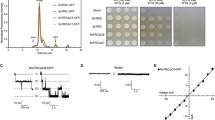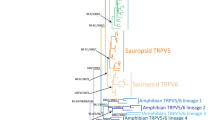Abstract
Trimeric intracellular cation-specific (TRIC) channels are integral to muscle excitation–contraction coupling. TRIC channels provide counter-ionic flux when calcium is rapidly transported from intracellular stores to the cell cytoplasm. Until recently, knowledge of the presence of these proteins was limited to animals. We analyzed the TRIC family and identified a profusion of prokaryotic family members with topologies and motifs similar to those of their eukaryotic counterparts. Prokaryotic members far outnumber eukaryotic members, and although none has been functionally characterized, the evidence suggests that they function as secondary carriers. The presence of fused N- or C-terminal domains of known biochemical functions as well as genomic context analyses provide clues about the functions of these prokaryotic homologs. They are proposed to function in metabolite (e.g., amino acid/nucleotide) efflux. Phylogenetic analysis revealed that TRIC channel homologs diverged relatively early during evolutionary history and that horizontal gene transfer was frequent in prokaryotes but not in eukaryotes. Topological analyses of TRIC channels revealed that these proteins possess seven putative transmembrane segments (TMSs), which arose by intragenic duplication of a three-TMS polypeptide-encoding genetic element followed by addition of a seventh TMS at the C terminus to give the precursor of all current TRIC family homologs. We propose that this family arose in prokaryotes.







Similar content being viewed by others
References
Altschul SF, Madden TL, Schaffer AA, Zhang J, Zhang Z, Miller W, Lipman DJ (1997) Gapped BLAST and PSI-BLAST: a new generation of protein database search programs. Nucleic Acids Res 25:3389–3402
Au KM, Barabote RD, Hu KY, Saier MH Jr (2006) Evolutionary appearance of H+-translocating pyrophosphatases. Microbiology 152:1243–1247
Bailey TL, Elkan C (1995) The value of prior knowledge in discovering motifs with MEME. Proc Int Conf Syst Mol Biol 3:21–29
Chan H, Babayan V, Blyumin E, Gandhi C, Hak K, Harake D, Kumar K, Lee P, Li TT, Liu HY, Lo TCT, Meyer CJ, Stanford S, Zamora KS, Saier MH Jr (2010) The P-type ATPase superfamily. J Mol Microbiol Biotechnol 19:5–104
Chung YJ, Krueger C, Metzgar D, Saier MH Jr (2001) Size comparisons among integral membrane transport protein homologues in Bacteria, Archaea, and Eucarya. J Bacteriol 183:1012–1021
Coronado R, Miller C (1980) Decamethonium and hexamethonium block K+ channels of sarcoplasmic reticulum. Nature 288:495–497
Courties C, Vaquer A, Troussellier M, Lautier J, Chrétiennot-Dinet MJ, Neveux J, Machado C, Claustre H (1994) Smallest eukaryotic organism. Nature 370:255
Cowan SW, Schirmer T, Rummer G, Steiert M, Ghosh R, Pauptit RA, Jansonius JN, Rosenbusch JP (1992) Crystal structures explain functional properties of two E. coli porins. Nature 358:727–733
Derelle E, Ferraz C, Rombauts S, Rouzé P, Worden AZ, Robbens S, Partensky F, Degroeve S, Echeynié S, Cooke R, Saeys Y, Wuyts J, Jabbari K, Bowler C, Panaud O, Piégu B, Ball SG, Ral JP, Bouget FY, Piganeau G, De Baets B, Picard A, Delseny M, Demaille J, Van de Peer Y, Moreau H (2006) Genome analysis of the smallest free-living eukaryote Ostreococcus tauri unveils many unique features. Proc Natl Acad Sci USA 103:11647–11652
Devereux J, Haeberli P, Smithies O (1984) A comprehensive set of sequence analysis programs for the VAX. Nucleic Acids Res 12:387–395
Doolittle RF (1981) Similar amino acid sequences: chance or common ancestry? Science 214:149–159
Doolittle RF (1986) Of urfs and orfs: a primer on how to analyze derived amino acid sequences. University Science Books, Mill Valley, CA
Eddy SR (1998) Multiple alignment and multiple sequence based searches. http://selab.janelia.org/publications/Eddy98b/Eddy98b-preprint.pdf
Eddy SR (2008) A probabilistic model of local sequence alignment that simplifies statistical significance estimation. PloS Comput Biol 4:e1000069
Fink RH, Stephenson DG (1987) Ca2+ movements in muscle modulated by the state of K+-channels in the sarcoplasmic reticulum membranes. Pflugers Arch 409:374–380
Gadsby DC (2009) Ion channels versus ion pumps: the principal difference, in principle. Nat Rev Mol Cell Biol 10:344–352
Gafvelin G, Sakaguchi M, Andersson H, von Heijne G (1997) Topological rules for membrane protein assembly in eukaryotic cells. J Biol Chem 272:6119–6127
Gophna U, Thompson JR, Boucher Y, Doolittle WF (2006) Complex histories of genes encoding 3-hydroxy-3-methylglutaryl-coenzymeA reductase. Mol Biol Evol 23:168–178
Krogh A, Larsson B, von Heijne G, Sonnhammer EL (2001) Predicting transmembrane protein topology with a hidden Markov model: application to complete genomes. J Mol Biol 305:567–580
Kuan G, Saier MH Jr (1994) Phylogenetic relationships among bacteriorhodopsins. Res Microbiol 145:273–285
Lang BF, Gray MW, Burger G (1999) Mitochondrial gene evolution and the origin of eukaryotes. Annu Rev Genet 33:351–397
Lerat E, Daubin V, Ochman H, Moran NA (2005) Evolutionary origins of genomic repertoires in bacteria. PLoS Biol 3:e130
Matias MG, Gomolplitinant KM, Tamang DG, Saier MH Jr (2010) Animal Ca2+ release-activated Ca2+ (CRAC) channels appear to be homologous to and derived from the ubiquitous cation diffusion facilitators. BMC Res Notes 3:158
Meissner G (1994) Ryanodine receptor/Ca2+ release channels and their regulation by endogenous effectors. Annu Rev Physiol 56:485–508
Mio K, Kubo Y, Ogura T, Yamamoto T, Sato C (2005) Visualization of the trimeric P2X2 receptor with a crown-capped extracellular domain. Biochem Biophys Res Commun 337:998–1005
Overbeek R, Begley T, Butler RM, Choudhuri JV, Chuang H-Y, Cohoon M, de Crécy-Lagard V, Diaz N, Disz T, Edwards R, Fonstein M, Frank ED, Gerdes S, Glass EM, Goesmann A, Hanson A, Iwata-Reuyl D, Jensen R, Jamshidi N, Krause L, Kubal M, Larsen N, Linke B, McHardy AC, Meyer F, Neuweger H, Olsen G, Olson R, Osterman A, Portnoy V, Pusch GD, Rodionov DA, Rückert C, Steiner J, Stevens R, Thiele I, Vassieva O, Ye Y, Zagnitko O, Vonstein V (2005) The subsystems approach to genome annotation and its use in the project to annotate 1000 genomes. Nucleic Acids Res 33:5691–5702
Pitt SJ, Park KH, Nishi M, Urashima T, Aoki S, Yamazaki D, Ma J, Takeshima H, Sitsapesan R (2010) Charade of the SR K+-channel: two ion-channels, TRIC-A and TRIC-B, masquerade as a single K+-channel. Biophys J 99:417–426
Rios E, Ma JJ, Gonzalez A (1991) The mechanical hypothesis of excitation–contraction (EC) coupling in skeletal muscle. J Muscle Res Cell Motil 12:127–135
Rios E, Pizarro G, Stefani E (1992) Charge movement and the nature of signal transduction in skeletal muscle excitation–contraction coupling. Annu Rev Physiol 54:109–133
Saier MH Jr (1994) Computer-aided analyses of transport protein sequences: gleaning evidence concerning function, structure, biogenesis, and evolution. Microbiol Rev 58:71–93
Saier MH Jr (2003a) Answering fundamental questions in biology with bioinformatics. ASM News 69:175–180
Saier MH Jr (2003b) Tracing pathways of transport protein evolution. Mol Microbiol 48:1145–1156
Saier MH Jr, Yen MR, Noto K, Tamang DG, Elkan C (2009) The transporter classification database: recent advances. Nucleic Acids Res 37:D274–D278
Schneider MF (1994) Control of calcium release in functioning skeletal muscle fibers. Annu Rev Physiol 54:463–484
Smets BF, Barkay R (2005) Horizontal gene transfer: perspectives at a crossroads of scientific disciplines. Nat Rev Microbiol 3:675–678
Takeshima H, Komazaki S, Hirose K, Nishi M, Noda T, Iino M (1998) Embryonic lethality and abnormal cardiac myocytes in mice lacking ryanodine receptor type 2. EMBO J 17:3309–3316
Thompson JD, Gibson TJ, Plewniak F, Jeanmougin F, Higgins DG (1997) The Clustal_X Windows interface: flexible strategies for multiple sequence alignment aided by quality analysis tools. Nucleic Acids Res 25:4876–4882
Tusnády GE, Simon I (1998) Principles governing amino acid composition of integral membrane proteins: application to topology prediction. J Mol Biol 283:489–506
Tusnády GE, Simon I (2001) The HMMTOP transmembrane topology prediction server. Bioinformatics 17:849–850
von Heijne G (1986) The distribution of positively charged residues in bacterial inner membrane proteins correlates with the trans-membrane topology. EMBO J 5:3021–3027
von Heijne G (1992) Membrane protein structure prediction: hydrophobicity analysis and the positive-inside rule. J Mol Biol 225:487–494
Wang B, Dukarevich M, Sun EI, Yen MR, Saier MH Jr (2009) Membrane porters of ATP-binding cassette transport systems are polyhyletic. J Membr Biol 1:1–10
Weisleder N, Takeshima H, Ma J (2008) Immuno-proteomic approach to excitation–contraction coupling in skeletal and cardiac muscle: molecular insights revealed by the mitsugumins. Cell Calcium 43:1–8
Woese CR (2000) Interpreting the universal phylogenetic tree. Proc Natl Acad Sci USA 97:8392–8396
Wong T, Amidi A, Dodds A, Siddiqi S, Wang J, Yep T, Tamang DG, Saier MH Jr (2007) Evolution of the bacterial flagellum. Microbe 2:335–340
Yamazaki D, Komazaki S, Nakanishi H, Mishima A, Nishi M, Yazawa M, Yamazaki T, Taguchi R, Takeshima H (2009a) Essential role of the TRIC-B channel in Ca2+ handling of alveolar epithelial cells and in perinatal lung maturation. Development 136:2355–2361
Yamazaki D, Yamazaki T, Takeshima H (2009b) Physiological functions of TRIC channels. Seikagaku 81:1004–1008
Yazawa M, Ferrante C, Feng J, Mio K, Ogura T, Zhang M, Lin P-H, Pan Z, Komazaki S, Kato K, Nishi M, Zhao X, Weisleder N, Sato C, Ma J, Takeshima H (2007) TRIC channels are essential for Ca2+ handling in intracellular stores. Nature 448:78–83
Yen MR, Choi J, Saier MH Jr (2009) Bioinformatic analyses of transmembrane transport: novel software for deducing protein phylogeny, topology, and evolution. J Mol Microbiol Biotechnol 17:163–176
Zhai Y, Saier MH Jr (2001a) A Web-based program (WHAT) for the simultaneous prediction of hydropathy, amphipathicity, secondary structure and transmembrane topology for a single protein sequence. J Mol Microbiol Biotechnol 3:501–502
Zhai Y, Saier MH Jr (2001b) A Web-based program for the prediction of average hydropathy, average amphipathicity and average similarity of multiply aligned homologous proteins. J Mol Microbiol Biotechnol 3:285–286
Zhai Y, Saier MH Jr (2002) A simple sensitive program for detecting internal repeats in sets of multiply aligned homologous proteins. J Mol Microbiol Biotechnol 4:375–377
Zhai Y, Heijne WH, Smith DW, Saier MH Jr (2001) Homologues of archaeal rhodopsins in plants, animals and fungi: structural and functional predictions for a putative fungal chaperone protein. Biochim Biophys Acta 1511:206–223
Zhai Y, Tchieu J, Saier MH Jr (2002) A Web-based Tree View (TV) program for the visualization of phylogenetic trees. J Mol Microbiol Biotechnol 4:69–70
Zhao X, Yamazaki D, Park KH, Komazaki S, Tjondrokoesoemo A, Nishi M, Lin P, Hirata Y, Brotto M, Takeshima H, Ma J (2010) Ca2+ overload and sarcoplasmi reticulum instability in TRIC—a null skeletal muscle. J Biol Chem 285:37370–37376
Acknowledgment
We acknowledge the computational expertise and instructive efforts of Dorjee G. Tamang, Dr. Joshua Kohn for useful advice on phylogenetic tree construction and analysis and the NIH (GM077402) for financial support.
Author information
Authors and Affiliations
Corresponding author
Electronic supplementary material
Below is the link to the electronic supplementary material.
Rights and permissions
About this article
Cite this article
Silverio, A.L.F., Saier, M.H. Bioinformatic Characterization of the Trimeric Intracellular Cation-Specific Channel Protein Family. J Membrane Biol 241, 77–101 (2011). https://doi.org/10.1007/s00232-011-9364-8
Received:
Accepted:
Published:
Issue Date:
DOI: https://doi.org/10.1007/s00232-011-9364-8




